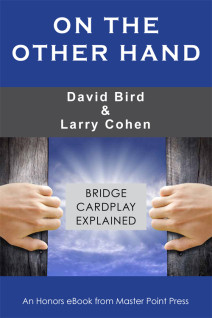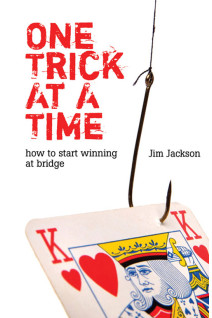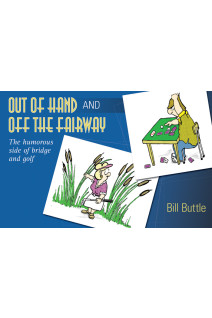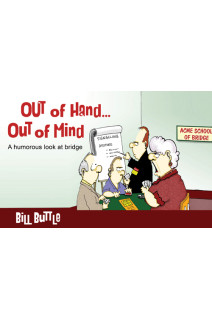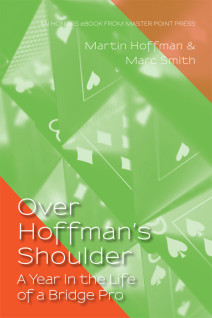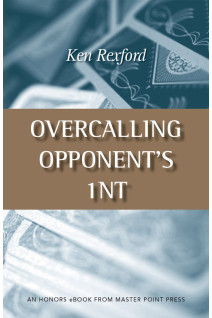All titles available from Master Point Press
Below is a complete list of all titles from Master Point Press
Off-Road Declarer Play
Every intermediate player is familiar with the routine techniques of dummy play. What this book describes are less well-known stratagems that may save the day in non-routine situations. They include methods for creating entries, surviving bad trump breaks, elopements, getting the defenders to help you out, and many more. In this unique and quirky book, the author introduces to the reader to new ways of thinking about declarer play, ways that just might help him make that next contract!
On the Other Hand
A New Way to Learn Bridge Cardplay In this unusual book, David Bird and Larry Cohen combine to present cardplay instruction in a new way. 100 pairs of deals are shown — one described by David and the other by Larry. The deals look similar (in some cases very similar) but an entirely different line of play is necessary to make each of the contracts. Only by clearly understanding the techniques involved will you be able to tackle such deals when you encounter them at the table.
One Trick at a Time
Coming March 2012 This is not a book for players who win regularly at their local bridge club – it is for those who don’t, but would like to. The author does not claim to be a top-level expert, and admits that he made many mistakes on his way to earning the coveted title of Life Master. This book is intended to help others avoid those same mistakes and to learn from those that they do make. Written in a conversational, non-technical style, this is a book that will help any intermediate player become a better bidder, a better declarer, a better defender, and a better partner – the recipe for becoming a winner.
Optimal Hand Evaluation
Accurately Assess the Value of Your Combined Hands Accurate hand evaluation is critically important to reaching the right contract in bridge. Yet, for over 75 years now, hand evaluation has essentially relied on Milton Work’s 4-3-2-1 honor point count — a count known to be seriously flawed and inaccurate. The method gives a very unsatisfactory, inaccurate point count which leads, too often, to the wrong contract. In this book, the author addresses these flaws by applying corrections to the 4-3-2-1 honor point count and to Goren’s distribution point count to obtain optimal accuracy — and introduces revolutionary new findings that lead to accurate hand evaluation. Most importantly, this new Optimal hand evaluation accurately assesses the value of both hands combined, the true test of hand evaluation. Over 100 example hands clearly establish that the Work/Goren point count is simply erroneous and that various other current methods do not yet offer a better alternative. Reviews "This is an important book for those interested in understanding the many factors that contribute to valuing bridge hands accurately and for those unfamiliar with the work of Vernes." -- The Bridge World
Optimal Hand Evaluation in Competitive Bidding
In his first book, Optimal Hand Evaluation, the author introduced a number of corrections to the Goren point count to reach "optimal" hand evaluation accuracy. That first book focused on non-competitive bidding situations where no further adjustments were needed as a result of the opponents' bidding. This book now deals with this specific topic. First, it challenges the very premise of the Law of Total Tricks and compares the results of its application "at the table" by world-class players to the effectiveness of the Optimal point count. Then, it reveals how to precisely quantify: - The point-count adjustments that should be applied to hands that are short or long in a suit bid by the opponents. - Which point-count adjustments should be made to honors. - How adjustments translate a hand's Offense to Defense ratio. - What adjustments apply to balanced hands. This book begins with an overview and two-page summary of the Optimal point count. The full rationale and statistical support data justifying the point count can be found in the first book, as well as over 100 example hands illustrating its accuracy. Reviews "The author espouses a very unusual and interesting way of estimating a hand’s value. Could Optimal be much better than the methods we have been employing all along? The author fervently believes so, and he may well be right." -- The Bridge World, May 2021
Out of Hand... And Off the Fairway
Canadian cartoonist Bill Buttle is well-known to readers of The Bridge Bulletin in the USA for his trenchant lampooning of bridge and bridge players. In this, his first collection, he aims his darts not only at bridge players but golfers. This book of hilarious one-panel cartoons will make a great gift for any bridge nut or golf addict.
Out of Hand... Out of Mind
Bill Buttle's 'Out of Hand' cartoon panels appear regularly in a number of bridge magazines, notably the ACBL's monthly Bulletin. This is his first collection devoted solely to bridge humor.
Over Hoffman's Shoulder
After surviving the Nazi death camps, Martin Hoffman moved to England and discovered a talent for bridge. He went on to achieve great success in tournament play, and at his peak was known as the best pairs player in Europe, if not in the world. He was especially skilled at scoring well despite playing with much weaker partners. His chief weapons were his speed of thought, his imagination, and his brilliant cardplay. In this exciting book, Martin Hoffman joins with bridge writer Marc Smith to tell the reader exactly what his thinking was while he was playing some of his most spectacular deals -- from the initial bidding, right through to their triumphant conclusion.
Overcalling Opponent's 1NT
Using Two-Under Overcalls for One or Both Majors, or for One or Both Minors Author Ken Rexford has developed an intriguing new approach to overcalling 1NT openings that may revolutionize this area of bridge. If you are unhappy with Cappelletti, DONT, Brozel, and the like, this book introduces you to a new approach for tackling the opponent's 1NT opening, with an entirely new way to handle one or two-suited hands. Can your current approach tell partner whether you have a strong or a weak overcall at the two-level? Can you tell partner which suit of your major-or-a-minor is longer? Can you identify the specific minor with your major, again at the two-level? All of these are possible using Ken Rexford's methods. Imagine describing more hands than the Woolsey defense handles, all with easy but novel methods that fit (unlike Woolsey) into the ACBL's General Convention Chart! You can also use these methods to improve your response structure to your own openings and in other auctions. For example, after a Four Diamond overcall of partner's Two Clubs opening, you can bid any new suit as a natural one-suiter, use double as cooperative, and yet still have the room needed to describe any specific two-suiter, without bypassing the game level. Impossible? Not with this new technique. Can you show one or both minors and slam interest after a 2NT opening, and tell partner which specific minor you have, at the three-level? Yes, using Rexford's methods.

